child seat Seat Alhambra 2011 Owner's Manual
[x] Cancel search | Manufacturer: SEAT, Model Year: 2011, Model line: Alhambra, Model: Seat Alhambra 2011Pages: 385, PDF Size: 7.92 MB
Page 5 of 385
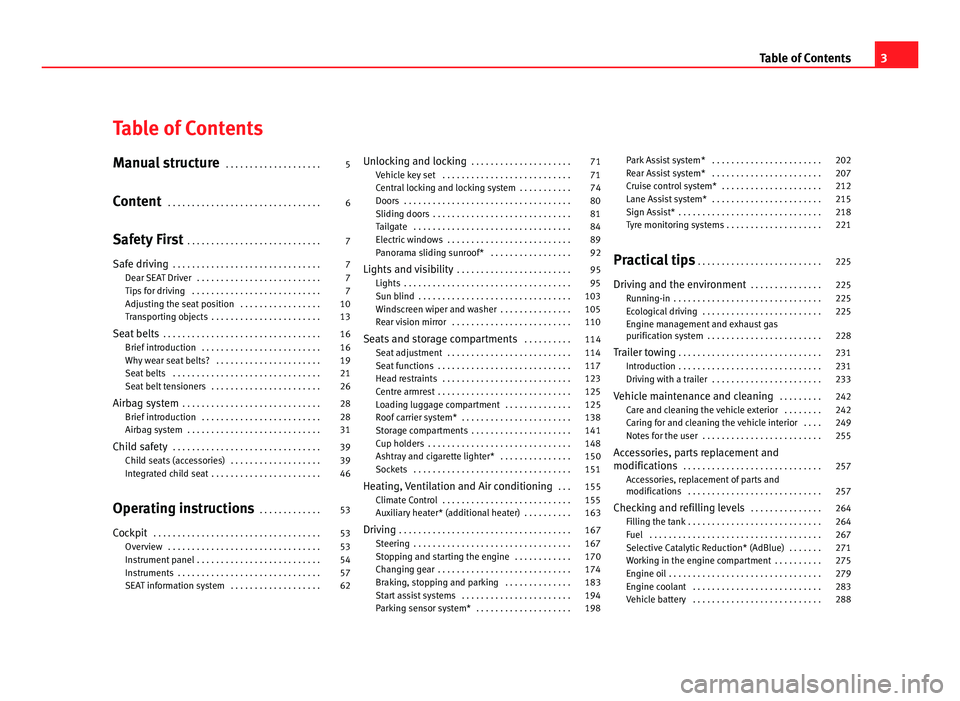
Table of Contents
Manual structure
. . . . . . . . . . . . . . . . . . . . 5
Content . . . . . . . . . . . . . . . . . . . . . . . . . . . . . . . . 6
Safety First . . . . . . . . . . . . . . . . . . . . . . . . . . . . 7
Safe driving . . . . . . . . . . . . . . . . . . . . . . . . . . . . . . . 7
Dear SEAT Driver . . . . . . . . . . . . . . . . . . . . . . . . . . 7
Tips for driving . . . . . . . . . . . . . . . . . . . . . . . . . . . 7
Adjusting the seat position . . . . . . . . . . . . . . . . . 10
Transporting objects . . . . . . . . . . . . . . . . . . . . . . . 13
Seat belts . . . . . . . . . . . . . . . . . . . . . . . . . . . . . . . . . 16
Brief introduction . . . . . . . . . . . . . . . . . . . . . . . . . 16
Why wear seat belts? . . . . . . . . . . . . . . . . . . . . . . 19
Seat belts . . . . . . . . . . . . . . . . . . . . . . . . . . . . . . . 21
Seat belt tensioners . . . . . . . . . . . . . . . . . . . . . . . 26
Airbag system . . . . . . . . . . . . . . . . . . . . . . . . . . . . . 28
Brief introduction . . . . . . . . . . . . . . . . . . . . . . . . . 28
Airbag system . . . . . . . . . . . . . . . . . . . . . . . . . . . . 31
Child safety . . . . . . . . . . . . . . . . . . . . . . . . . . . . . . . 39
Child seats (accessories) . . . . . . . . . . . . . . . . . . . 39
Integrated child seat . . . . . . . . . . . . . . . . . . . . . . . 46
Operating instructions . . . . . . . . . . . . . 53
Cockpit . . . . . . . . . . . . . . . . . . . . . . . . . . . . . . . . . . . 53
Overview . . . . . . . . . . . . . . . . . . . . . . . . . . . . . . . . 53
Instrument panel . . . . . . . . . . . . . . . . . . . . . . . . . . 54
Instruments . . . . . . . . . . . . . . . . . . . . . . . . . . . . . . 57
SEAT information system . . . . . . . . . . . . . . . . . . . 62 Unlocking and locking
. . . . . . . . . . . . . . . . . . . . . 71
Vehicle key set . . . . . . . . . . . . . . . . . . . . . . . . . . . 71
Central locking and locking system . . . . . . . . . . . 74
Doors . . . . . . . . . . . . . . . . . . . . . . . . . . . . . . . . . . . 80
Sliding doors . . . . . . . . . . . . . . . . . . . . . . . . . . . . . 81
Tailgate . . . . . . . . . . . . . . . . . . . . . . . . . . . . . . . . . 84
Electric windows . . . . . . . . . . . . . . . . . . . . . . . . . . 89
Panorama sliding sunroof* . . . . . . . . . . . . . . . . . 92
Lights and visibility . . . . . . . . . . . . . . . . . . . . . . . . 95
Lights . . . . . . . . . . . . . . . . . . . . . . . . . . . . . . . . . . . 95
Sun blind . . . . . . . . . . . . . . . . . . . . . . . . . . . . . . . . 103
Windscreen wiper and washer . . . . . . . . . . . . . . . 105
Rear vision mirror . . . . . . . . . . . . . . . . . . . . . . . . . 110
Seats and storage compartments . . . . . . . . . . 114
Seat adjustment . . . . . . . . . . . . . . . . . . . . . . . . . . 114
Seat functions . . . . . . . . . . . . . . . . . . . . . . . . . . . . 117
Head restraints . . . . . . . . . . . . . . . . . . . . . . . . . . . 123
Centre armrest . . . . . . . . . . . . . . . . . . . . . . . . . . . . 125
Loading luggage compartment . . . . . . . . . . . . . . 125
Roof carrier system* . . . . . . . . . . . . . . . . . . . . . . . 138
Storage compartments . . . . . . . . . . . . . . . . . . . . . 141
Cup holders . . . . . . . . . . . . . . . . . . . . . . . . . . . . . . 148
Ashtray and cigarette lighter* . . . . . . . . . . . . . . . 150
Sockets . . . . . . . . . . . . . . . . . . . . . . . . . . . . . . . . . 151
Heating, Ventilation and Air conditioning . . . 155
Climate Control . . . . . . . . . . . . . . . . . . . . . . . . . . . 155
Auxiliary heater* (additional heater) . . . . . . . . . . 163
Driving . . . . . . . . . . . . . . . . . . . . . . . . . . . . . . . . . . . . 167
Steering . . . . . . . . . . . . . . . . . . . . . . . . . . . . . . . . . 167
Stopping and starting the engine . . . . . . . . . . . . 170
Changing gear . . . . . . . . . . . . . . . . . . . . . . . . . . . . 174
Braking, stopping and parking . . . . . . . . . . . . . . 183
Start assist systems . . . . . . . . . . . . . . . . . . . . . . . 194
Parking sensor system* . . . . . . . . . . . . . . . . . . . . 198 Park Assist system* . . . . . . . . . . . . . . . . . . . . . . . 202
Rear Assist system* . . . . . . . . . . . . . . . . . . . . . . . 207
Cruise control system* . . . . . . . . . . . . . . . . . . . . . 212
Lane Assist system* . . . . . . . . . . . . . . . . . . . . . . . 215
Sign Assist* . . . . . . . . . . . . . . . . . . . . . . . . . . . . . . 218
Tyre monitoring systems . . . . . . . . . . . . . . . . . . . . 221
Practical tips . . . . . . . . . . . . . . . . . . . . . . . . . . 225
Driving and the environment . . . . . . . . . . . . . . . 225
Running-in . . . . . . . . . . . . . . . . . . . . . . . . . . . . . . . 225
Ecological driving . . . . . . . . . . . . . . . . . . . . . . . . . 225
Engine management and exhaust gas
purific ation sy
stem . . . . . . . . . . . . . . . . . . . . . . . . 228
Trailer towing . . . . . . . . . . . . . . . . . . . . . . . . . . . . . . 231
Introduction . . . . . . . . . . . . . . . . . . . . . . . . . . . . . . 231
Driving with a trailer . . . . . . . . . . . . . . . . . . . . . . . 233
Vehicle maintenance and cleaning . . . . . . . . . 242
Care and cleaning the vehicle exterior . . . . . . . . 242
Caring for and cleaning the vehicle interior . . . . 249
Notes for the user . . . . . . . . . . . . . . . . . . . . . . . . . 255
Accessories, parts replacement and
modifications . . . . . . . . . . . . . . . . . . . . . . . . . . . . .
257
Accessories, replacement of parts and
modifications
. . . . . . . . . . . . . . . . . . . . . . . . . . . . 257
Checking and refilling levels . . . . . . . . . . . . . . . 264
Filling the tank . . . . . . . . . . . . . . . . . . . . . . . . . . . . 264
Fuel . . . . . . . . . . . . . . . . . . . . . . . . . . . . . . . . . . . . 267
Selective Catalytic Reduction* (AdBlue) . . . . . . . 271
Working in the engine compartment . . . . . . . . . . 275
Engine oil . . . . . . . . . . . . . . . . . . . . . . . . . . . . . . . . 279
Engine coolant . . . . . . . . . . . . . . . . . . . . . . . . . . . 283
Vehicle battery . . . . . . . . . . . . . . . . . . . . . . . . . . . 288 3
Table of Contents
Page 10 of 385
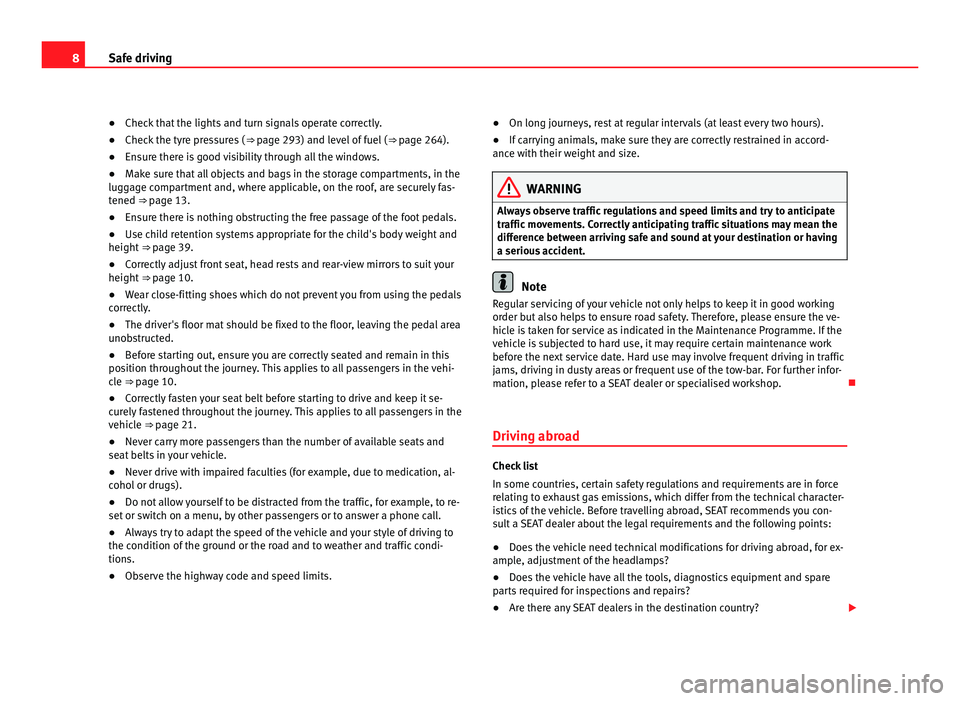
8
Safe driving
● Check that the lights and turn signals operate correctly.
● Chec k
the tyre pressures ( ⇒ pag
e 293) and level of fuel (⇒ page 264).
● Ensure there is good visibility through all the windows.
● Make sure that all objects and bags in the storage compartments, in the
luggag
e compartment and, where applicable, on the roof, are securely fas-
tened ⇒ page 13.
● Ensure there is nothing obstructing the free passage of the foot pedals.
● Use child retention systems appropriate for the child's body weight and
height ⇒
page 39.
● Correctly adjust front seat, head rests and rear-view mirrors to suit your
height ⇒
page 10.
● Wear close-fitting shoes which do not prevent you from using the pedals
correctly
.
● The driver's floor mat should be fixed to the floor, leaving the pedal area
unob
structed.
● Before starting out, ensure you are correctly seated and remain in this
position thr
oughout the journey. This applies to all passengers in the vehi-
cle ⇒ page 10.
● Correctly fasten your seat belt before starting to drive and keep it se-
curely
fastened throughout the journey. This applies to all passengers in the
vehicle ⇒ page 21.
● Never carry more passengers than the number of available seats and
seat belts
in your vehicle.
● Never drive with impaired faculties (for example, due to medication, al-
cohol
or drugs).
● Do not allow yourself to be distracted from the traffic, for example, to re-
set or swit
ch on a menu, by other passengers or to answer a phone call.
● Always try to adapt the speed of the vehicle and your style of driving to
the condition of the gr
ound or the road and to weather and traffic condi-
tions.
● Observe the highway code and speed limits. ●
On long journeys, rest at regular intervals (at least every two hours).
● If c
arrying animals, make sure they are correctly restrained in accord-
ance with their w
eight and size. WARNING
Always observe traffic regulations and speed limits and try to anticipate
traffic mo
vements. Correctly anticipating traffic situations may mean the
difference between arriving safe and sound at your destination or having
a serious accident. Note
Regular servicing of your vehicle not only helps to keep it in good working
order b ut
also helps to ensure road safety. Therefore, please ensure the ve-
hicle is taken for service as indicated in the Maintenance Programme. If the
vehicle is subjected to hard use, it may require certain maintenance work
before the next service date. Hard use may involve frequent driving in traffic
jams, driving in dusty areas or frequent use of the tow-bar. For further infor-
mation, please refer to a SEAT dealer or specialised workshop.
Driving abroad Check list
In some cou
ntrie
s, certain safety regulations and requirements are in force
relating to exhaust gas emissions, which differ from the technical character-
istics of the vehicle. Before travelling abroad, SEAT recommends you con-
sult a SEAT dealer about the legal requirements and the following points:
● Does the vehicle need technical modifications for driving abroad, for ex-
ample, a
djustment of the headlamps?
● Does the vehicle have all the tools, diagnostics equipment and spare
parts
required for inspections and repairs?
● Are there any SEAT dealers in the destination country?
Page 12 of 385
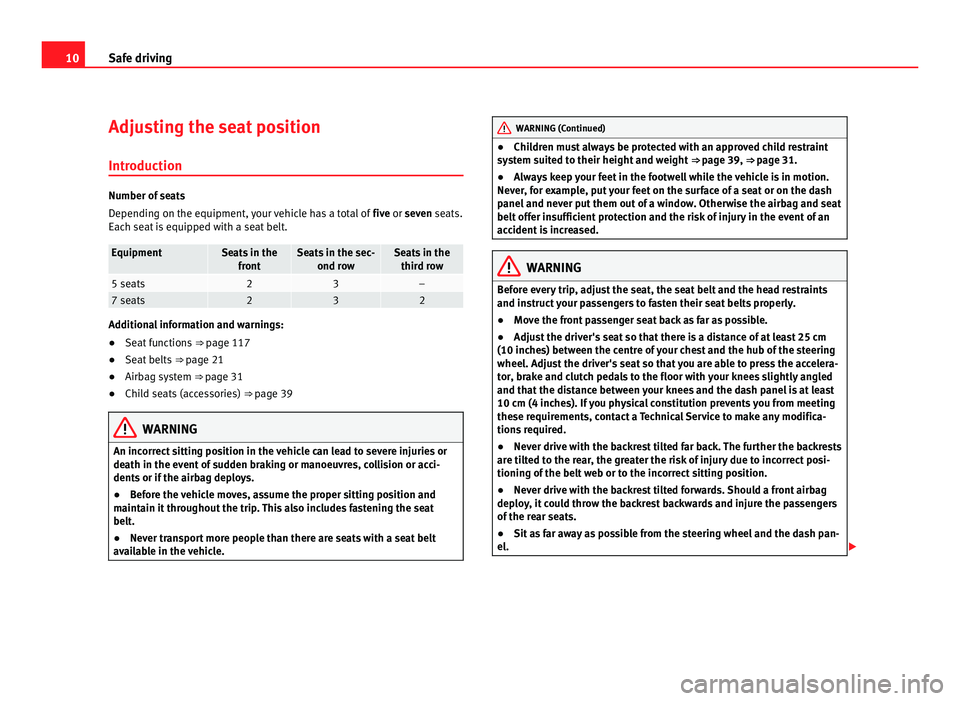
10
Safe driving
Adjusting the seat position
Introduction Number of seats
Dependin
g on the equipment,
your vehicle has a total of five or seven seats.
Each seat is equipped with a seat belt. Equipment Seats in the
front Seats in the sec-
ond ro w Seats in the
third r o
w 5 seats 2 3 –
7 seats 2 3 2
Additional information and warnings:
●
Seat functions ⇒ page 117
● Se
at belts ⇒ page 21
● Airb
ag system ⇒ page 31
● Chi
ld seats (accessories) ⇒ page 39WARNING
An incorrect sitting position in the vehicle can lead to severe injuries or
death in the ev ent
of sudden braking or manoeuvres, collision or acci-
dents or if the airbag deploys.
● Before the vehicle moves, assume the proper sitting position and
maintain it
throughout the trip. This also includes fastening the seat
belt.
● Never transport more people than there are seats with a seat belt
avail
able in the vehicle. WARNING (Continued)
● Children must always be protected with an approved child restraint
sy s
tem suited to their height and weight ⇒ page 39, ⇒ page 31.
● Always keep your feet in the footwell while the vehicle is in motion.
Never, f
or example, put your feet on the surface of a seat or on the dash
panel and never put them out of a window. Otherwise the airbag and seat
belt offer insufficient protection and the risk of injury in the event of an
accident is increased. WARNING
Before every trip, adjust the seat, the seat belt and the head restraints
and ins truct
your passengers to fasten their seat belts properly.
● Move the front passenger seat back as far as possible.
● Adjust the driver's seat so that there is a distance of at least 25 cm
(10 inches) betw
een the centre of your chest and the hub of the steering
wheel. Adjust the driver's seat so that you are able to press the accelera-
tor, brake and clutch pedals to the floor with your knees slightly angled
and that the distance between your knees and the dash panel is at least
10 cm (4 inches). If you physical constitution prevents you from meeting
these requirements, contact a Technical Service to make any modifica-
tions required.
● Never drive with the backrest tilted far back. The further the backrests
are tilt
ed to the rear, the greater the risk of injury due to incorrect posi-
tioning of the belt web or to the incorrect sitting position.
● Never drive with the backrest tilted forwards. Should a front airbag
deploy
, it could throw the backrest backwards and injure the passengers
of the rear seats.
● Sit as far away as possible from the steering wheel and the dash pan-
el.
Page 18 of 385
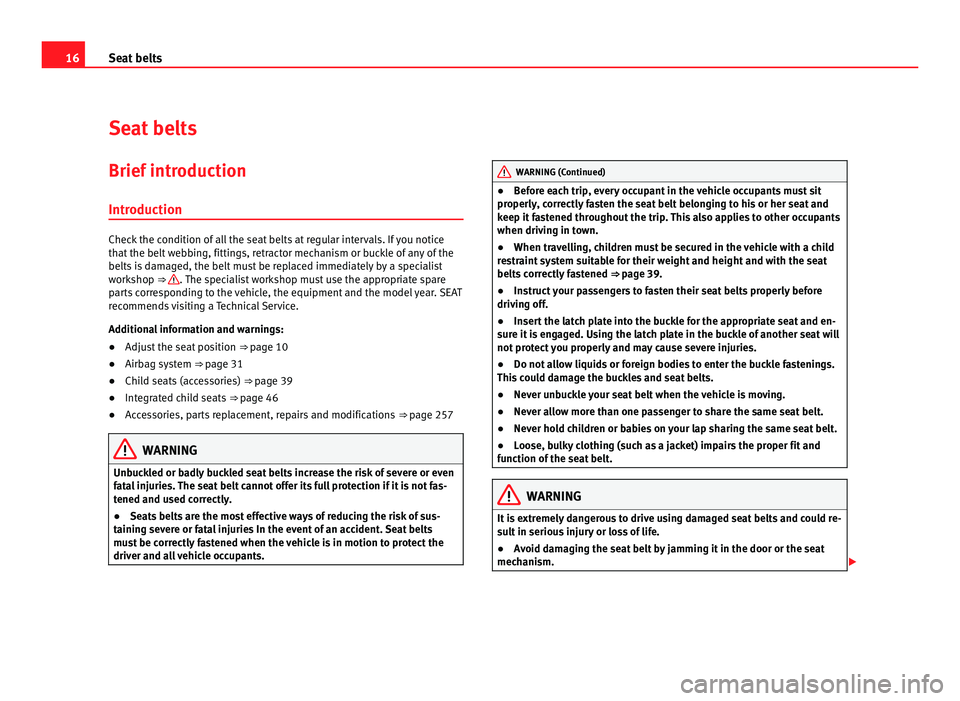
16
Seat belts
Seat belts
Brief introduction Introduction Check the condition of all the seat belts at regular intervals. If you notice
that
the belt
webbing, fittings, retractor mechanism or buckle of any of the
belts is damaged, the belt must be replaced immediately by a specialist
workshop ⇒ . The specialist workshop must use the appropriate spare
par ts
corresponding to the vehicle, the equipment and the model year. SEAT
recommends visiting a Technical Service.
Additional information and warnings:
● Adjust the seat position ⇒ page 10
● Airb
ag system ⇒ page 31
● Chi
ld seats (accessories) ⇒ page 39
● Int
egrated child seats ⇒ page 46
● A
ccessories, parts replacement, repairs and modifications ⇒ page 257WARNING
Unbuckled or badly buckled seat belts increase the risk of severe or even
fat a
l injuries. The seat belt cannot offer its full protection if it is not fas-
tened and used correctly.
● Seats belts are the most effective ways of reducing the risk of sus-
taining sev
ere or fatal injuries In the event of an accident. Seat belts
must be correctly fastened when the vehicle is in motion to protect the
driver and all vehicle occupants. WARNING (Continued)
● Before each trip, every occupant in the vehicle occupants must sit
pr operly
, correctly fasten the seat belt belonging to his or her seat and
keep it fastened throughout the trip. This also applies to other occupants
when driving in town.
● When travelling, children must be secured in the vehicle with a child
res
traint system suitable for their weight and height and with the seat
belts correctly fastened ⇒ page 39.
● Instruct your passengers to fasten their seat belts properly before
driving off
.
● Insert the latch plate into the buckle for the appropriate seat and en-
sure it
is engaged. Using the latch plate in the buckle of another seat will
not protect you properly and may cause severe injuries.
● Do not allow liquids or foreign bodies to enter the buckle fastenings.
This c
ould damage the buckles and seat belts.
● Never unbuckle your seat belt when the vehicle is moving.
● Never allow more than one passenger to share the same seat belt.
● Never hold children or babies on your lap sharing the same seat belt.
● Loose, bulky clothing (such as a jacket) impairs the proper fit and
function of
the seat belt. WARNING
It is extremely dangerous to drive using damaged seat belts and could re-
su lt
in serious injury or loss of life.
● Avoid damaging the seat belt by jamming it in the door or the seat
mechani
sm.
Page 30 of 385
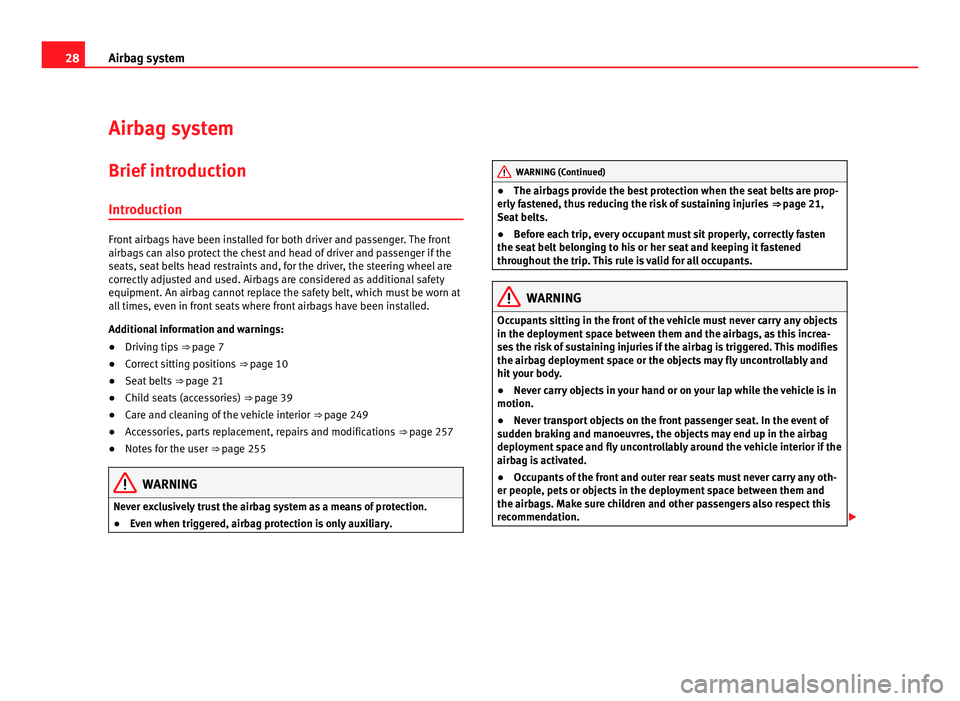
28
Airbag system
Airbag system
Brief introduction Introduction Front airbags have been installed for both driver and passenger. The front
airbag
s
can also protect the chest and head of driver and passenger if the
seats, seat belts head restraints and, for the driver, the steering wheel are
correctly adjusted and used. Airbags are considered as additional safety
equipment. An airbag cannot replace the safety belt, which must be worn at
all times, even in front seats where front airbags have been installed.
Additional information and warnings:
● Driving tips ⇒ pag
e 7
● Correct sitting positions ⇒ pag
e 10
● Seat belts ⇒ pag
e 21
● Child seats (accessories) ⇒ pag
e 39
● Care and cleaning of the vehicle interior ⇒ pag
e 249
● Accessories, parts replacement, repairs and modifications ⇒ pag
e 257
● Notes for the user ⇒ pag
e 255WARNING
Never exclusively trust the airbag system as a means of protection.
● Even when triggered, airbag protection is only auxiliary. WARNING (Continued)
● The airb ags provide the best protection when the seat belts are prop-
erly f
astened, thus reducing the risk of sustaining injuries ⇒ page 21,
Seat belts.
● Before each trip, every occupant must sit properly, correctly fasten
the seat belt
belonging to his or her seat and keeping it fastened
throughout the trip. This rule is valid for all occupants. WARNING
Occupants sitting in the front of the vehicle must never carry any objects
in the deplo yment
space between them and the airbags, as this increa-
ses the risk of sustaining injuries if the airbag is triggered. This modifies
the airbag deployment space or the objects may fly uncontrollably and
hit your body.
● Never carry objects in your hand or on your lap while the vehicle is in
motion.
● Never transport objects on the front passenger seat. In the event of
sudden br
aking and manoeuvres, the objects may end up in the airbag
deployment space and fly uncontrollably around the vehicle interior if the
airbag is activated.
● Occupants of the front and outer rear seats must never carry any oth-
er people, pet
s or objects in the deployment space between them and
the airbags. Make sure children and other passengers also respect this
recommendation.
Page 32 of 385
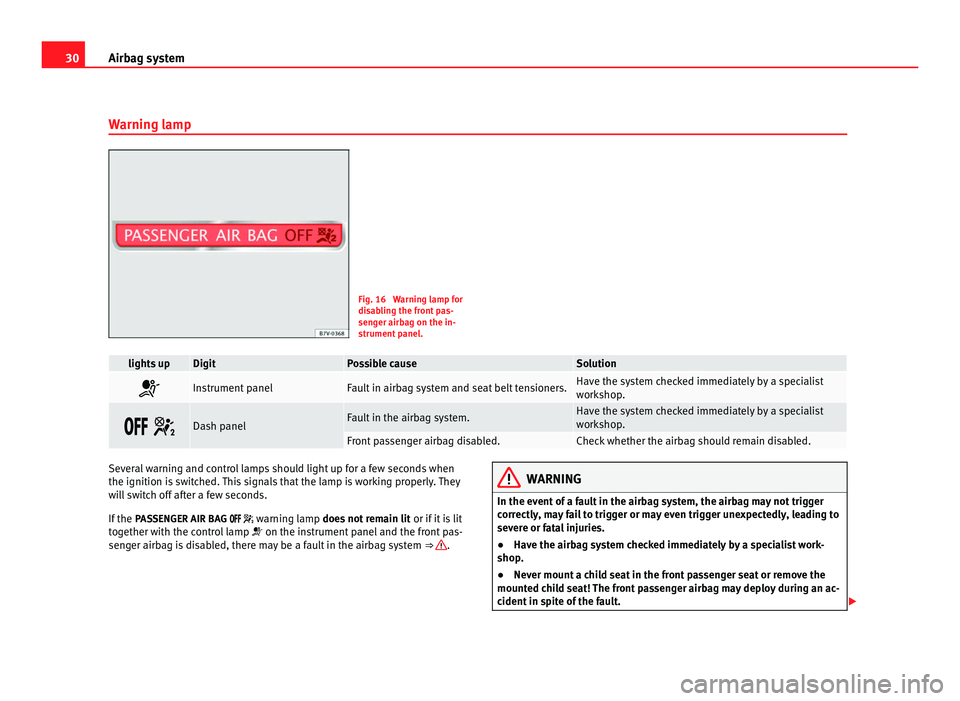
30
Airbag system
Warning lamp Fig. 16 Warning lamp for
dis
ab
ling the front pas-
senger airbag on the in-
strument panel. lights up Digit Possible cause Solution
Instrument panel Fault in airbag system and seat belt tensioners. Have the system checked immediately by a specialist
work
shop
. Dash panel Fault in the airbag system. Have the system checked immediately by a specialist
work
shop
. Front passenger airbag disabled. Check whether the airbag should remain disabled.
Several warning and control lamps should light up for a few seconds when
the ignition is
sw
itched. This signals that the lamp is working properly. They
will switch off after a few seconds.
If the PASSENGER AIR BAG warning lamp does not remain lit or if it is lit
together with the control lamp on the instrument panel and the front pas-
senger airbag is disabled, there may be a fault in the airbag system ⇒ . WARNING
In the event of a fault in the airbag system, the airbag may not trigger
corr ectly
, may fail to trigger or may even trigger unexpectedly, leading to
severe or fatal injuries.
● Have the airbag system checked immediately by a specialist work-
shop.
● Never mou
nt a child seat in the front passenger seat or remove the
mounted c
hild seat! The front passenger airbag may deploy during an ac-
cident in spite of the fault.
Page 34 of 385
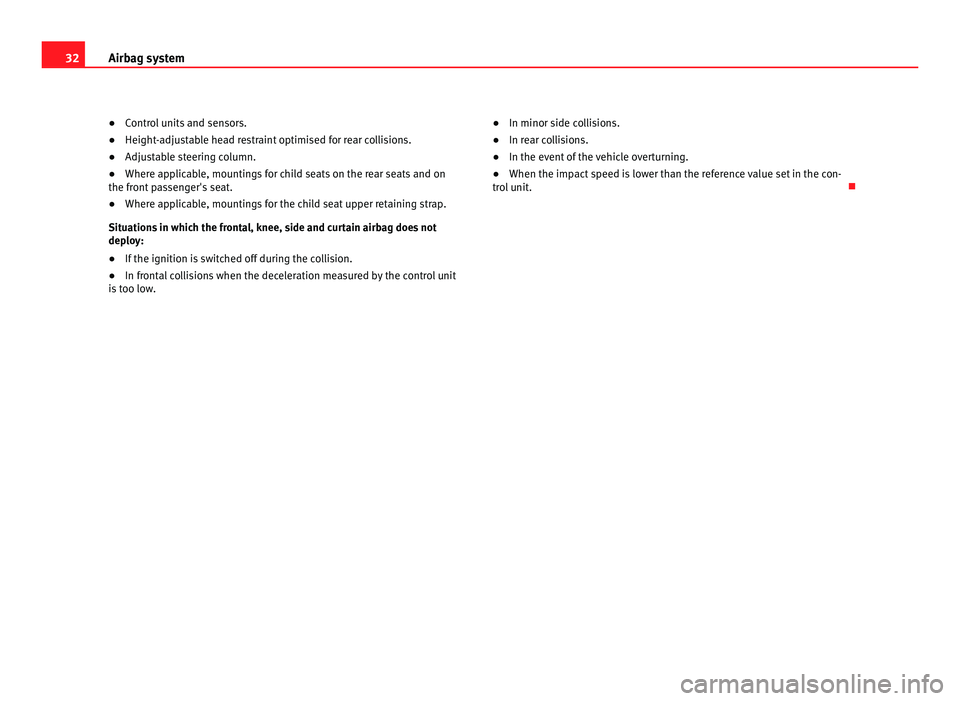
32
Airbag system
● Control units and sensors.
● Height -
adjustable head restraint optimised for rear collisions.
● Adjustable steering column.
● Where applicable, mountings for child seats on the rear seats and on
the front p
assenger's seat.
● Where applicable, mountings for the child seat upper retaining strap.
Situations
in which the frontal, knee, side and curtain airbag does not
deploy:
● If the ignition is switched off during the collision.
● In frontal collisions when the deceleration measured by the control unit
is t
oo low. ●
In minor side co
llisions.
● In rear collisions.
● In the event of the vehicle overturning.
● When the impact speed is lower than the reference value set in the con-
trol
unit.
Page 37 of 385
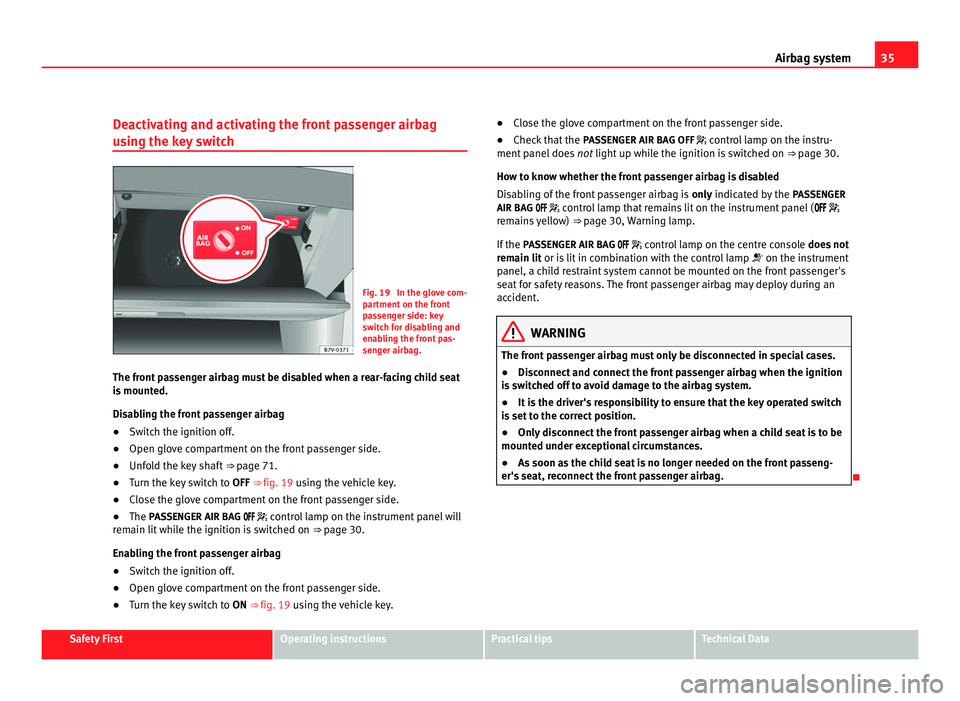
35
Airbag system
Deactivating and activating the front passenger airbag
us in
g the key switch Fig. 19 In the glove com-
par
tment
on the front
passenger side: key
switch for disabling and
enabling the front pas-
senger airbag.
The front passenger airbag must be disabled when a rear-facing child seat
is mou
nted.
Disabling the front passenger airbag
● Switch the ignition off.
● Open glove compartment on the front passenger side.
● Unfold the key shaft ⇒ page 71.
● T
urn the key switch to OFF ⇒ fig. 19 usin
g the vehicle key.
● Close the glove compartment on the front passenger side.
● The PASSENGER AIR BAG
control lamp on the instrument panel will
remain lit while the ignition is switched on ⇒ page 30.
Enabling the front passenger airbag
● Switch the ignition off.
● Open glove compartment on the front passenger side.
● Turn the key switch to ON ⇒ fig. 19 u
sing the vehicle key. ●
Close the glove compartment on the front passenger side.
● Check
that the PASS
ENGER AIR BAG OFF control lamp on the instru-
ment panel does not light up while the ignition is switched on ⇒ page 30.
How to know whether the front passenger airbag is disabled
Disabling of the front passenger airbag is only indicated by the PASSENGER
AIR BAG control lamp that remains lit on the instrument panel (
remains yellow) ⇒ page 30, Warning lamp.
If the PASSENGER AIR BAG control lamp on the centre console does not
remain lit or is lit in combination with the control lamp on the instrument
panel, a child restraint system cannot be mounted on the front passenger's
seat for safety reasons. The front passenger airbag may deploy during an
accident. WARNING
The front passenger airbag must only be disconnected in special cases.
● Disconnect and connect the front passenger airbag when the ignition
is sw
itched off to avoid damage to the airbag system.
● It is the driver's responsibility to ensure that the key operated switch
is set
to the correct position.
● Only disconnect the front passenger airbag when a child seat is to be
mounted u
nder exceptional circumstances.
● As soon as the child seat is no longer needed on the front passeng-
er's seat, r
econnect the front passenger airbag.
Safety First Operating instructions Practical tips Technical Data
Page 41 of 385
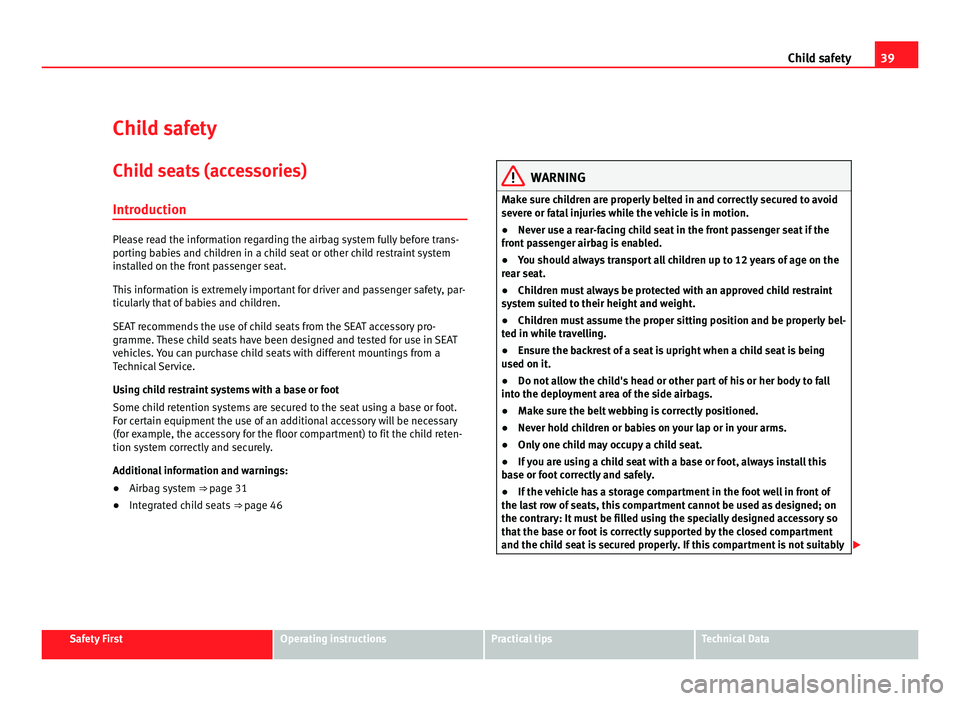
39
Child safety
Child safety
Child seats (accessories) Introduction Please read the information regarding the airbag system fully before trans-
portin
g b
abies and children in a child seat or other child restraint system
installed on the front passenger seat.
This information is extremely important for driver and passenger safety, par-
ticularly that of babies and children.
SEAT recommends the use of child seats from the SEAT accessory pro-
gramme. These child seats have been designed and tested for use in SEAT
vehicles. You can purchase child seats with different mountings from a
Technical Service.
Using child restraint systems with a base or foot
Some child retention systems are secured to the seat using a base or foot.
For certain equipment the use of an additional accessory will be necessary
(for example, the accessory for the floor compartment) to fit the child reten-
tion system correctly and securely.
Additional information and warnings:
● Airbag system ⇒ page 31
● Int
egrated child seats ⇒ page 46 WARNING
Make sure children are properly belted in and correctly secured to avoid
sever e or f
atal injuries while the vehicle is in motion.
● Never use a rear-facing child seat in the front passenger seat if the
front p
assenger airbag is enabled.
● You should always transport all children up to 12 years of age on the
rear se
at.
● Children must always be protected with an approved child restraint
syst
em suited to their height and weight.
● Children must assume the proper sitting position and be properly bel-
ted in whil
e travelling.
● Ensure the backrest of a seat is upright when a child seat is being
used on it.
● Do not
allow the child's head or other part of his or her body to fall
into the deplo
yment area of the side airbags.
● Make sure the belt webbing is correctly positioned.
● Never hold children or babies on your lap or in your arms.
● Only one child may occupy a child seat.
● If you are using a child seat with a base or foot, always install this
base or f
oot correctly and safely.
● If the vehicle has a storage compartment in the foot well in front of
the las
t row of seats, this compartment cannot be used as designed; on
the contrary: It must be filled using the specially designed accessory so
that the base or foot is correctly supported by the closed compartment
and the child seat is secured properly. If this compartment is not suitably Safety First Operating instructions Practical tips Technical Data
Page 42 of 385
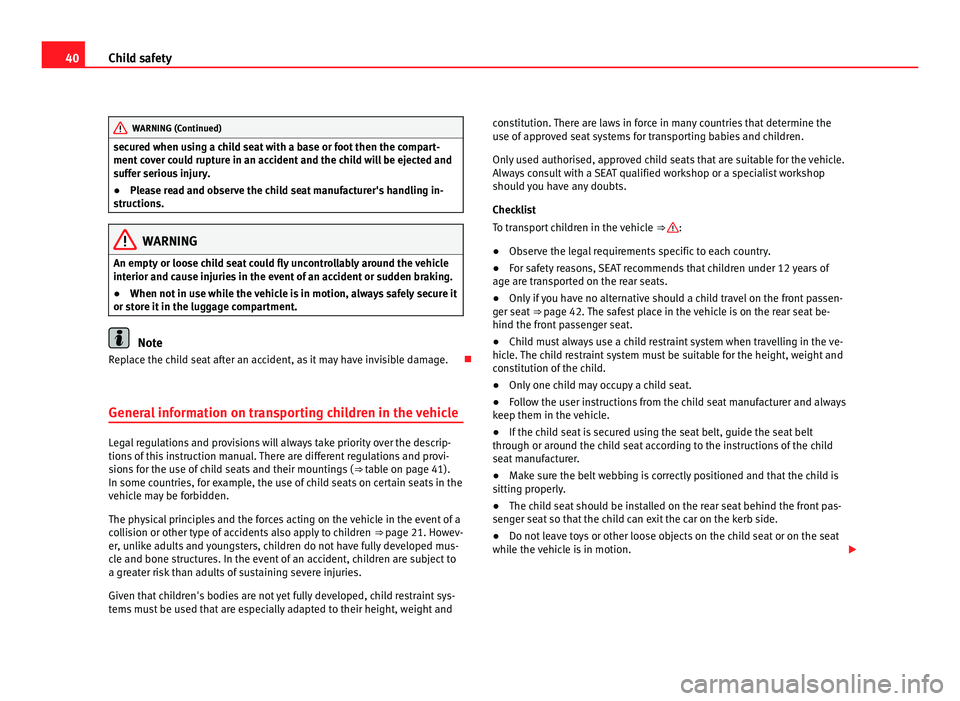
40
Child safety WARNING (Continued)
secured when using a child seat with a base or foot then the compart-
ment c
o
ver could rupture in an accident and the child will be ejected and
suffer serious injury.
● Please read and observe the child seat manufacturer's handling in-
structions. WARNING
An empty or loose child seat could fly uncontrollably around the vehicle
interior and c au
se injuries in the event of an accident or sudden braking.
● When not in use while the vehicle is in motion, always safely secure it
or stor
e it in the luggage compartment. Note
Replace the child seat after an accident, as it may have invisible damage.
General information on transporting children in the vehicle Legal regulations and provisions will always take priority over the descrip-
tions
of
this instruction manual. There are different regulations and provi-
sions for the use of child seats and their mountings ( ⇒ table on page 41).
In some countries, for example, the use of child seats on certain seats in the
vehicle may be forbidden.
The physical principles and the forces acting on the vehicle in the event of a
collision or other type of accidents also apply to children ⇒ page 21. Howev-
er, unlike adults and youngsters, children do not have fully developed mus-
cle and bone structures. In the event of an accident, children are subject to
a greater risk than adults of sustaining severe injuries.
Given that children's bodies are not yet fully developed, child restraint sys-
tems must be used that are especially adapted to their height, weight and constitution. There are laws in force in many countries that determine the
use of ap
proved seat systems for transporting babies and children.
Only used authorised, approved child seats that are suitable for the vehicle.
Always consult with a SEAT qualified workshop or a specialist workshop
should you have any doubts.
Checklist
To transport children in the vehicle ⇒ :
● Observe the legal requirements specific to each country.
● For safety reasons, SEAT recommends that children under 12 years of
age ar e tr
ansported on the rear seats.
● Only if you have no alternative should a child travel on the front passen-
ger seat
⇒ page 42. The safest place in the vehicle is on the rear seat be-
hind the front passenger seat.
● Child must always use a child restraint system when travelling in the ve-
hicle.
The child restraint system must be suitable for the height, weight and
constitution of the child.
● Only one child may occupy a child seat.
● Follow the user instructions from the child seat manufacturer and always
keep them in the v
ehicle.
● If the child seat is secured using the seat belt, guide the seat belt
through or arou
nd the child seat according to the instructions of the child
seat manufacturer.
● Make sure the belt webbing is correctly positioned and that the child is
sitting pr
operly.
● The child seat should be installed on the rear seat behind the front pas-
senger se
at so that the child can exit the car on the kerb side.
● Do not leave toys or other loose objects on the child seat or on the seat
while the
vehicle is in motion.